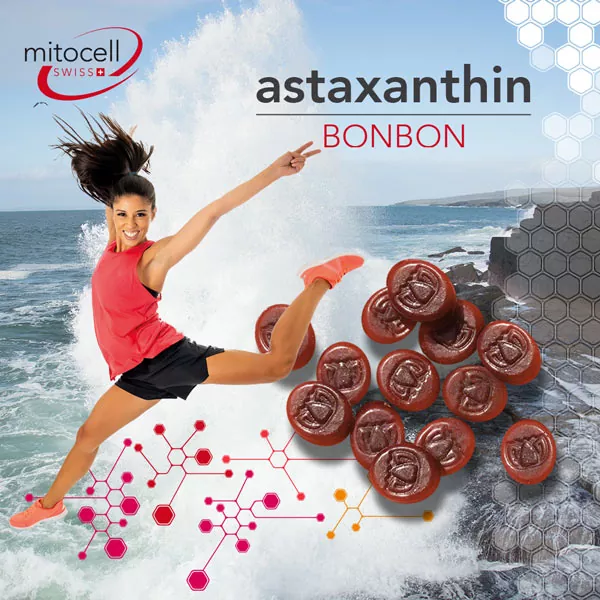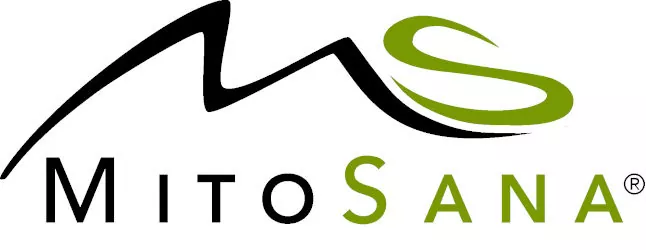-
Sie haben noch keine Artikel in Ihrem Warenkorb.
Astaxanthin – eins der stärksten und am besten erforschten Antioxidantien
Bei Astaxanthin handelt es sich um sogenannte Xanthophyll-Carotinoide – Pigmente, die für die gelb-orange Färbung in verschiedenen pflanzlichen und tierischen Produkten sorgen. Besonders reich an Astaxanthin sind Lachs, Krill, Garnelen, Forellen und vor allem die Alge Haematococcus pluvialis, die zur Nahrung der Vorbenannten zählt und auch der Grund ihrer Rotfärbung darstellt.Astaxanthin unterscheidet sich in seiner chemischen Struktur nur wenig von den anderen Carotinoiden. Doch dieser feine Unterschied ist entscheidend und sorgt für aussergewöhnliche Fähigkeiten, die das Astaxanthin stark von den Eigenschaften der anderen Carotinoide abhebt.
- So kann Astaxanthin beispielsweise die Blut-Hirn-Schranke überwinden und das Gehirn und die Nerven des Zentralen Nervensystems direkt vor Ort freien Radikalen schützen.
- Genauso kann das Astaxanthin die sog. Blut-Retina-Schranke überwinden und direkt in der Netzhaut für einen antioxidativen und entzündungshemmenden Schutz des Auges sorgen.
- Astaxanthin kann sich ausserdem äusserst effektiv im gesamten Körper verteilen, so dass seine schützende Wirkung jeder einzelnen Zelle und damit allen Organen, Geweben, Gelenken und der Haut zugute kommt.

In einem Experiment verglich man die antioxidative Wirkung von Astaxanthin mit derjenigen von Vitamin E – einem bekanntlich sehr starken Antioxidans. Dabei zeigte sich, dass Astaxanthin in Bezug auf die Neutralisierung des aktiven und reaktionsfreudigen Singulett-Sauerstoffs 550-mal stärker wirkt als Vitamin E (Shimidzu et al., 1996).
Eine zweite Studie testete die Fähigkeit verschiedener Antioxidantien, freie Radikale zu eliminieren. Ins Rennen gingen u. a. Vitamin E, Vitamin C, Beta-Carotin und Astaxanthin. Es zeigte sich, dass Astaxanthin fast 20-mal besser wirkte als Vitamin E, über 50-mal besser als Beta-Carotin und über 60-mal stärker als Vitamin C (Bagchi, 2001, Creighton University).
Wer sein Wissen weiter vertiefen möchte, der kann sich sehr umfangreich z.B. beim Zentrum der Gesundheit unter folgendem Link informieren:
https://www.zentrum-der-gesundheit.de/artikel/nahrungsergaenzung/astaxanthin-ia

ZUM PRODUKT
Weitere Referenzen und Studien zum Thema:
1. Abidov M, Ramazanov Z, Seifulla R et al. The effects of Xanthigen in the weight management of obese premenopausal women with non-alcoholic fatty liver disease and normal liver fat. Diabetes Obes Metab. 2010;12(1):72-81.2. Aggarwal BB, Kirshnan S, Guha S, ed. Inflammation, lifestyle, and chronic disease. The silent link. CRC Press, 2012. ISBN 978-1-4398-3989-8.
3. Ambati RR, Phang SM, Ravi S et al. Astaxanthin: sources, extraction, stability, biological activities and its commercial applications--a review. Mar Drugs. 2014;12(1):128-52.
4. Aoi W, Naito Y, Takanami Y et al. Astaxanthin improves muscle lipid metabolism in exercise via inhibitory effect of oxidative CPT I modification. Biochem Biophys Res Commun. 2008;366(4):892-7.
5. Arunkumar E, Bhuvaneswari S, Anuradha CV. An intervention study in obese mice with astaxanthin, a marine carotenoid - effects on insulin signaling and pro-inflammatory cytokines. Food Funct. 2012;3(2):120-6.
6. Bhuvaneswari S, Anuradha CV. Astaxanthin prevents loss of insulin signaling and improves glucose metabolism in liver of insulin resistant mice. Can J Physiol Pharmacol. 2012;90(11):1544-52.
7. Bhuvaneswari S, Yogalakshmi B, Sreeja S et al. Astaxanthin reduces hepatic endoplasmic reticulum stress and nuclear factor-κB-mediated inflammation in high fructose and high fat diet-fed mice. Cell Stress Chaperones. 2014;19(2):183-91.
8. Bosma-den Boer MM, van Wetten ML, Pruimboom L. Chronic inflammatory diseases are stimulated by current lifestyle: how diet, stress levels and medication prevent our body from recovering. Nutr Metab (Lond). 2012;9(1):32.
9. Calder PC, Ahluwalia N, Brouns F et al. Dietary factors and low-grade inflammation in relation to overweight and obesity. Br J Nutr. 2011;106:S5–78.
10. de Vries MA, Klop B, Eskes SA et al. The postprandial situation as a pro-inflammatory condition. Clin Investig Arterioscler. 2014;26(4):184-92.
11. degranulation of mast cells via suppression of antigen-induced aggregation of high affinity IgE receptor. J Biol Chem. 2009;284:28172-28179.
12. D'Orazio N, Gemello E, Gammone MA et al. Fucoxantin: a treasure from the sea. Mar Drugs. 2012;10(3):604-16.
13. Fassett RG, Coombes JS. Astaxanthin in cardiovascular health and disease. Molecules. 2012;17(2):2030-48.
14. Fassett RG, Coombes JS. Astaxanthin in cardiovascular health and disease. Molecules 2012;17:2030-2048.
15. Ha AW, Kim WK. The effect of fucoxanthin rich powder on the lipid metabolism in rats with a high fat diet. Nutr Res Pract. 2013;7(4):287-93.
16. Ha AW, Na SJ, Kim WK. Antioxidative effects of fucoxanthin rich powder in rats fed with high fat diet. Nutr Res Pract. 2013;7(6):475-80.
17. Heo SJ, Yoon WJ, Kim KN et al. Evaluation of anti-inflammatory effect of fucoxanthin isolated from brown algae in lipopolysaccharide-stimulated RAW 264.7 macrophages. Food Chem Toxicol. 2010;48:2045-2051.
18. Hosokawa M, Miyashita T, Nishikawa S et al. Fucoxanthin regulates adipocytokine mRNA expression in white adipose tissue of diabetic/obese KK-Ay mice. Arch Biochem Biophys. 2010;504(1):17-25.
19. Hotamisligil GS, Erbay E. Nutrient sensing and inflammation in metabolic diseases. Nat Rev Immunol. 2008;8(12):923-34.
20. Ikeuchi M, Koyama T, Takahashi J et al. Effects of astaxanthin in obese mice fed a high-fat diet. Biosci Biotechnol Biochem. 2007;71:893-899.
21. Jia Y, Kim JY, Jun HJ et al. The natural carotenoid astaxanthin, a PPAR-α agonist and PPAR-γ antagonist, reduces hepatic lipid accumulation by rewiring the transcriptome in lipid-loaded hepatocytes. Mol Nutr Food Res. 2012;56(6):878-88.
22. Kawashima T. A marine carotenoid, fucoxanthin, induces regulatory T cells and inhibits Th17 cell differentiation in vitro. Biosci Biotechnol Biochem. 2011;75(10):2066-2069.
23. Kim KN, Heo SJ, Yoon WJ et al. Fucoxanthin inhibits the inflammatory response by suppressing the activation of NF-jB and MAPKs in lipopolysaccharide-induced RAW 264.7 macrophages. Eur J Pharmacol. 2010;649:369-375.
24. Li W, Hellsten A, Jacobsson LS et al. Alpha-tocopherol and astaxanthin decrease macrophage infiltration, apoptosis and vulnerability in atheroma of hyperlipidaemic rabbits. J Mol Cell Cardiol. 2004;37(5):969-78.
25. Maeda H et al. Fucoxanthin from edible seaweed, Undaria pinnatifida, shows antiobesity effect through UCP1 expression in white adipose tissues. Biochem Biophys Res Commun. 2005;332(2):392-7. Maeda H et al. Fucoxanthin and its metabolite, fucoxanthinol, suppress adipocyte differentiation in 3T3-L1 cells. Int J Mol Med. 2006;18(1):147-52.
26. Matsumoto M, Hosokawa M, Matsukawa N et al. Suppressive effects of the marine carotenoids, fucoxanthin and fucoxanthinol on triglyceride absorption in lymph duct-cannulated rats. Eur J Nutr. 2010;49(4):243-9.
27. Miyawaki H, Takahashi J, Tsukahara H et al. Effects of astaxanthin on human blood rheology. J Clin Biochem Nutr. 2008;43(2):69-74.
28. Nakagawa K, Kiko T, Miyazawa T et al. Antioxidative effect of astaxanthin on phospholipid peroxidation in human erythrocytes. Br J Nutr. 2011;105(11):1563-71.
29. Park HJ, Lee MK, Park YB et al. Beneficial effects of Undaria pinnatifida ethanol extract on diet-induced-insulin resistance in C57BL/6J mice. Food Chem Toxicol. 2010;13:357-363.
30. Park JS, Chyun JH, Kim YK et al. Astaxanthin decreased oxidative stress and inflammation and enhanced immune response in humans. Nutr Metab. 2010;7:1-10.
31. Riccioni G, D'Orazio N, Franceschelli S et al. Marine carotenoids and cardiovascular risk markers. Mar Drugs. 2011;9(7):1166-75.
32. Riccioni G. Marine carotenoids and oxidative stress. Mar Drugs. 2012;10(1):116-8.
33. Sakai S, Sugawara T, Matsubara K et al. Inhibitory effect of carotenoids on the
34. Shiratori K, Ohgami K, Ilieva I et al. Effects of fucoxanthin on lipopolysaccharide-induced inflammation in vitro and in vivo. Exp Eye Res. 2005;81(4):422-8.
35. Spiller GA, Dewell A. Safety of an astaxanthin-rich Haematococcus pluvialis algal extract: a randomized clinical trial. J Med Food. 2003;6(1):51-6.
36. Tan CP, Hou YH. First evidence for the anti-inflammatory activity of fucoxanthin in high-fat-diet-induced obesity in mice and the Antioxidative functions in PC12 cells. Inflammation. 2014;37(2):443-50.
37. Yang Y, Kim B, Lee JY. Astaxanthin structure, metabolism, and health benefits. J Hum Nutr Food Sci. 2013;1:1003.
